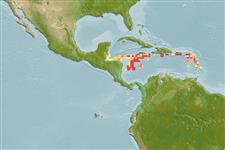Élasmobranches (requins et raies) (sharks and rays) >
Carcharhiniformes (Ground sharks) >
Pentanchidae (Deepwater catsharks)
Etymology: Apristurus: a-, Latin privative, i.e., without; pristis, from pristes (Gr.), sawyer (but here meaning saw); oura (Gr.), tail, referring to absence of saw-toothed crest of enlarged dermal denticles along upper edge of caudal fin as found in the closely related Pristiurus (=Galeus) (See ETYFish); canutus: Latin for hoary (gray or ash-colored), referring to its dark-gray coloration (with minute white spots underneath denticles) (See ETYFish).
Eponymy: Canutus is Latin for grey or ash-coloured and nothing to do with the tide-defying King Canute. (Ref. 128868), visit book page.
Environment: milieu / climate zone / depth range / distribution range
Écologie
marin bathydémersal; profondeur 500 - 1000 m (Ref. 55584). Deep-water; 18°N - 13°N
Western Central Atlantic: leeward islands off Antigua and Anguilla.
Taille / Poids / Âge
Maturity: Lm ? range ? - ? cm
Max length : 43.0 cm TL mâle / non sexé; (Ref. 244); 45.0 cm TL (female)
A deepwater bottom shark found on the insular slopes off the leeward islands. Oviparous (Ref. 50449). Poorly known. Not utilized at present.
Life cycle and mating behavior
Maturité | Reproduction | Frai | Œufs | Fécondité | Larves
Oviparous, paired eggs are laid. Embryos feed solely on yolk (Ref. 50449). Females spawn off leeward islands (Ref. 244).
Compagno, L.J.V., 1984. FAO Species Catalogue. Vol. 4. Sharks of the world. An annotated and illustrated catalogue of shark species known to date. Part 2 - Carcharhiniformes. FAO Fish. Synop. 125(4/2):251-655. Rome: FAO. (Ref. 244)
Statut dans la liste rouge de l'IUCN (Ref. 130435: Version 2024-2)
Menace pour l'homme
Harmless
Utilisations par l'homme
Pêcheries: sans intérêt
Outils
Articles particuliers
Télécharger en XML
Sources Internet
Estimates based on models
Preferred temperature (Ref.
123201): 6.6 - 9, mean 7.3 °C (based on 7 cells).
Phylogenetic diversity index (Ref.
82804): PD
50 = 0.5000 [Uniqueness, from 0.5 = low to 2.0 = high].
Bayesian length-weight: a=0.00355 (0.00175 - 0.00721), b=3.08 (2.90 - 3.26), in cm total length, based on LWR estimates for this (Sub)family-body shape (Ref.
93245).
Niveau trophique (Ref.
69278): 3.8 ±0.4 se; based on size and trophs of closest relatives
Résilience (Ref.
120179): Très faible, temps minimum de doublement de population supérieur à 14 ans (Fec assumed to be <10).
Fishing Vulnerability (Ref.
59153): Low to moderate vulnerability (35 of 100).
